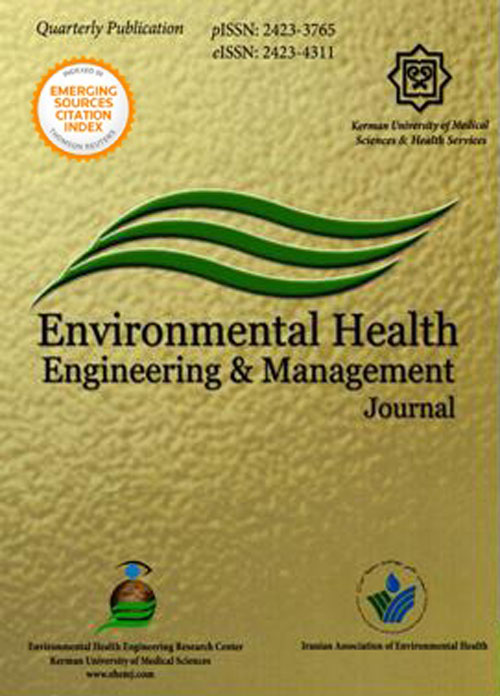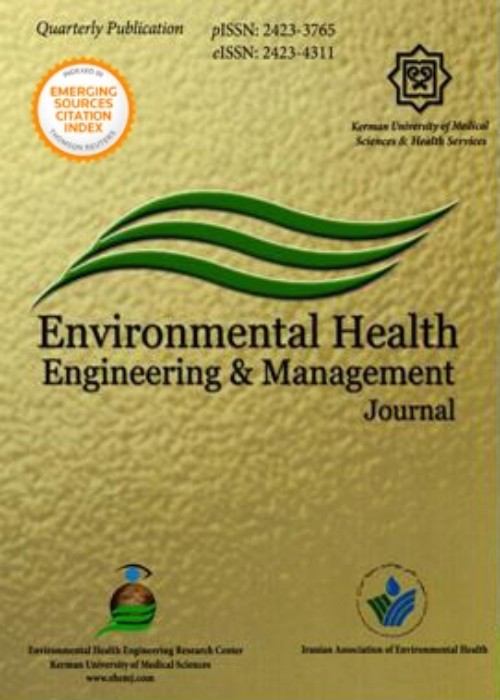فهرست مطالب

Environmental Health Engineering and Management Journal
Volume:6 Issue: 2, Spring 2019
- تاریخ انتشار: 1398/03/11
- تعداد عناوین: 8
-
-
Pages 81-88BackgroundMetoprolol (MTP) with its low biodegradability is one of the most dominant micropollutant in the effluent of wastewater treatment plants. The aim of this study was to investigate the removal of metoprolol from aqueous solutions by the activated carbon prepared from pine cones.MethodsThe pine cones were activated using thermal activation method. Characteristics of the adsorbent were determined using Brunauer-Emmett-Teller (BET) and scanning electron microscopy (SEM). In this study, the influent of different parameters such as pH, contact time, initial concentrations of metoprolol, adsorbent dose, temperature, adsorption isotherms, and kinetics were investigated.ResultsThe maximum removal efficiency of MTP (89.2%) was obtained at pH=8.5, adsorbent dose=1.5 g, contact time=60 min, and initial concentration=50 mg/L. By increasing the adsorbent dose, the removal efficiency also increased, but the adsorption capacity decreased, however, by increasing the initial concentration, the removal efficiency decreased, but the adsorption capacity increased. The isotherm experimental data for metoprolol was best fitted using the Langmuir model, and kinetic data were better described by pseudo-second-order kinetic model. The thermodynamic study indicated that the adsorption of MTP by the adsorbent was feasible, spontaneous, and endothermic.ConclusionMTP removal by the activated carbon prepared from pine cones showed that this natural adsorbent is appropriate for removal of metoprolol from aqueous solutions regarding cost, efficiency, and production method.Keywords: Metoprolol, Adsorption, Pine cones, Isotherm, Kinetics, Thermodynamics
-
Pages 89-96BackgroundThe aim of this study was to investigate the frequency and type of bacteria resistant to chloramphenicol (CHL), erythromycin (E), and sulfamethoxazole (SXT) antibiotics from untreated wastewater effluents to receiving river.MethodsIn total, 32 samples were taken from eight sites located in the raw wastewater to the downstream of the receiving Ghotor river in Khoy city. Resistant microorganisms were studied through modified HPC method and CLSI standards. Different and specific colonies were selected and re-cultured in R2A culture medium and enough colonies were used for DNA extraction. Bacterial 16sr RNA target gene was amplified and sequenced. Pseudomonas sp., Comamonas sp., and Thiobacillus sp. were predominant bacterial species identified in water samples. Also, antibiotic-resistant genes (ARGs) including sul1,
ermB, and cmlA1 were tracked by PCR.ResultsThe average total number of antibiotic-resistant bacteria (ARB) increased in the downstream (2.4×102 to 2.6×104 CFU/100 mL). The comparison of the results related to the river’s upstream and downstream also indicated a significant difference between ARB and ARGs contents (P<0.05). The average number of bacteria resistant to SXT, E, and CHL antibiotics was obtained to be 2.3×104, 2.3×104, and 3.4×104 CFU/mL, respectively. Finally, the evaluation of water revealed that only the aeration lagoon was able to decline the number of CHL-resistant bacteria (88.9%) while this process increased the number of SXT- (51%) and E- (16%) resistant bacteria. The lowest and highest percentages of the identified genes were related to ermB (12.5%) and sul1 (81.25%), respectively.ConclusionAccording to the results, wastewaters play an important role in releasing ARB and their antibiotic resistance genes to downstream of Ghotor rivers in Khoy city.Keywords: Heterotrophic bacteria, Sulfamethoxazole, Chloramphenicol, Erythromycin, Polymerase chain reaction, Wastewater, Rivers -
Pages 97-104BackgroundAs a human carcinogen, formaldehyde is a toxic chemical imposing adverse effects on public health and environment. Due to its high reactivity, colorless nature, sustainability, purity in commercial forms, and low prices, the production and consumption of this compound has expanded vastly in industries.MethodsIn this study, a UVC photoreactor with a total volume of 120 mL was used and operated in a rotary mode. To determine the residual concentration, high-performance liquid chromatography (HPLC) device was applied whose detector was set at a wavelength of 355 nm and equipped with C18 column (with dimensions of 25 × 4.6 mm i.d, and particle size of 5 µm). Total organic carbon (TOC) was determined using a TOC analyzer.ResultsThe optimal condition in this study was obtained at pH=3 and formaldehyde concentration of 350 mg, so that the removal of formaldehyde and TOC was 98.2% and 95.1%, respectively, after 35 minutes reaction time. The formaldehyde removal efficiency was assessed in the presence of methanol (MeOH), tert-butyl alcohol (TBA), and salicylic acid (SA) scavengers, and it was indicated that SO4•- radicals were the most effective factors in formaldehyde destruction. By increasing the concentrations of MeOH, TBA, and SA to 2.5 g/L, the degradation efficiency of formaldehyde dropped from 98.02% to 69.78%, 64.68%, and 45.14%, respectively, at 35 minutes reaction time. The removal of formaldehyde in the presence of nitrate was significantly reduced and it had a significant effect on the removal of formaldehyde.ConclusionIn this study, the removal of formaldehyde was investigated in the presence of various anions including bicarbonate, carbonate, chloride, sulfate, and nitrate. According to the results, the UVC/S 2O82- process is a convenient and cost-effective method for the removal of formaldehyde.Keywords: Formaldehyde, Advanced oxidation, Bicarbonates, Carbonates, Sulfates, Nitrates
-
Pages 105-111BackgroundConstructed wetlands are systems designed based on the utilization of natural processes, including vegetation, soil, and their associated microbial assemblage to assist in treating different types of wastewater.MethodsTwo local Appalachian plants (Louis latifolia and Phragmites australis) were planted into smallscale constructed wetlands to treat domestic wastewater in the North of Iran. Te influent wastewater and the efuent from each wetland were sampled daily for 120 days. Experiments were conducted based on the mean ± standard deviation (SD) by analysis of variance (ANOVA).ResultsIt was found that nitrate, phosphate, fecal and total coliforms were reduced by 84.4%, 94.4%, 96.3%, 93.9% for P. australis and 73.3%, 64.0%, 94.4%, 92.1% for L. latifolia, respectively.ConclusionAccording to the results, by using the HF-CW technology with L. latifolia and P. australis plants, the treated wastewater fully meets the wastewater discharge parameters of WHO standards.Keywords: Nitrate, Phosphate, Wetland, Wastewater treatment, Iran
-
Pages 113-120BackgroundConsidering the carcinogenic effects of heavy metals, such as chromium, it is essential to remove these elements from water and wastewater. Direct osmosis is a new membrane technology, which can be a proper alternative to conventional chromium removal processes.MethodsThe wastewater samples were collected from an electroplating unit, located in Alborz industrial city, Qazvin, Iran. Magnesium chloride was used as the draw solution, and a semipermeable membrane (Aquaporin) was used in this study. The experiments were designed, using response surface methodology (RSM) and central composite design (CCD) with draw solution concentration (0.5- 1.5 M), feed solution concentration (4-12 mg/L), and experiment time (30-90 minutes) as variable factors. The chromium concentration and water flux were also measured, based on atomic absorption spectrophotometry and water flux equation, respectively.ResultsDirect osmosis was highly efficient in chromium removal and water recycling. Water flux and chromium removal efficiency were 15.6 LMH and 85.58%, respectively, under optimal conditions (draw solution = 1.27 mol/L, feed solution = 4 mg/L, and experiment time = 90 min). In terms of validity, the results predicted by the quadratic polynomial model were in good agreement with the responses reported in the laboratory.ConclusionIn direct osmosis, the use of magnesium chloride as the draw solution resulted in the acceptable chromium removal from electroplating wastewater. Using this method, chromium concentration in wastewater reduced to a level lower than the discharge standards, established by Iran’s Department of Environment.Keywords: Direct osmosis, Chromium removal, Electroplating, Optimization
-
Pages 121-128BackgroundAlthough anaerobic system has been successfully used for treating the strong industrial wastewater, its efficiency for low-strength wastewater as municipal wastewater is not satisfying. This study aimed to enhance the capability of an anaerobic baffled reactor (ABR) for treating municipal wastewater.MethodsA 7-L ABR with 5 compartments was operated for a 287-day period fed with primary effluent from a wastewater treatment plant at 17 to 19°C. The study was conducted in 2 phases. In the first phase, the performance of ABR and in the second phase, the performance of ESABR (ABR integrated with an electrochemical system) were investigated.ResultsThe results of ABR operation indicated that at hydraulic retention time (HRT) =24 hours, the average removal efficiency of biochemical oxygen demand (BOD), chemical oxygen demand (COD), total suspended solids (TSS), total Kjeldahl nitrogen (TKN), total phosphorous (TP), and log reduction value (LRV) of coliforms were obtained to be 71%, 75%, 79%, 23%, 30.3%, and 5.8 Log, respectively. In this phase, when the HRT was decreased from 24 to 18 hours and from 18 to 14 hours, the removal efficiency of all parameters by the ABR was decreased. After the shift of ABR operation to ESABR, at HRT=24 hours and current density of 0.78 mA/cm2, the performance of the reactor was enhanced, so that the removal efficiency of BOD, COD, TSS, TKN, TP, and LRV of coliforms were achieved 16.8%, 15%, 4%, 10.7%, 49%, and 1 Log, which was greater than those obtained by ABR.ConclusionAccording to the results, this technology (SEABR) is suitable for treating the low-strength municipal wastewater.Keywords: Wastewater, Anaerobic baffled reactor, Electrical stimulated, Treatment
-
Pages 129-137BackgroundThe release of metals from industrial factories is one of the most important sources of environmental pollution. The present study aimed to determine the concentration of heavy metals like cadmium (Cd), chromium (Cr), manganese (Mn), nickel (Ni), and lead (Pb) in dust around the cement factory.MethodsA total of 22 dust samples were collected from areas around the cement factory in Isfahan province in spring and summer and transferred to laboratory for chemical digestion. Risk index (RI), integrated pollution index (IPI), mean of contamination degree (mCd), and contamination factor (Cfi) were calculated to determine the contamination status.ResultsThe concentration of heavy metals in the falling dust around the factory was expressed as CdConclusionAccording to the results, the deposited dust of study area is considered as a polluted dust and it is at higher risk of pollution with Cd and Cr.Keywords: Cement factory, Dust, Environmental pollution, Heavy metals
-
Pages 139-149BackgroundChanges in temperature and precipitation pattern seriously affect the amount of river runoff coming into Dam Lake. These changes could influence the operating conditions of reservoir systems such as Jor hydropower reservoir system (Malaysia) with the total capacity of 150 MW. So, it is necessary to analyze the effect of changes in weather parameters on the river runoff and consequently, the hydropower production.MethodsIn this research, LARS-WG was used to downscale the weather parameters such as daily minimum temperature, maximum temperature, and precipitation based on one of the general circulation sub-model (HADCM3) under three emission scenarios, namely, A1B, A2, and B1 for the next 50 years. Then, the artificial neural network (ANN) was constructed, while rainfall and evapotranspiration were used as input data and river runoff as output data to discover the relationship between climate parameters and runoff at the present and in the future time.ResultsIt was revealed that the monthly mean temperature will increase approximately between 0.3-0.7°C, while the mean monthly precipitation will vary from -22% to +22% in the next 50 years. These changes could shift the dry and wet seasons and consequently, change the river runoff volume. In most months, the results of models integration showed reductions in river runoff.ConclusionIt can be concluded that the output of hydropower reservoir system is highly dependent on the river runoff. So, the impacts of climate changes should be considered by the reservoir operators/managers to reduce these impacts and secure water supplies.Keywords: Climate change, Neural Networks, Malaysia, Weather, Temperature


